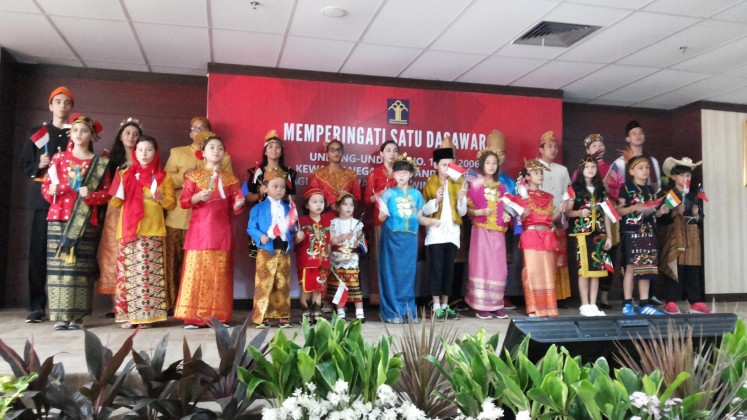Inul Daratista: Turning around adversity
Who has not heard of Inul Daratista? Her controversial gyrating dance style turned her into a renowned dangdut singer
Change Size

W
ho has not heard of Inul Daratista? Her controversial gyrating dance style turned her into a renowned dangdut singer. Undeniably, Inul's dance movements have mesmerized her many fans both here and abroad, consisting of men, women and children.
Inul, who was born in Pasuruan, East Java, became a big hit and a media favorite. After her success as a singer, Inul, who is the oldest of six children of Abdullah Aman and Rufi a, turned her attention to business by opening a chain of family karaoke halls and cafes called Inul Vizta. She said her new business was in anticipation of a downturn in her popularity.
Inul said, "In 2004, I suddenly received fewer bookings and due to complaints that my dance style was too erotic, my shows were restricted and many of my gigs were canceled," recalled Inul, whose real name is Ainur Rokhimah.
At the time she was very confused and did not know what to do. She could not decide whether to stay in Jakarta or return to her hometown. Staying in Jakarta seemed out of the question as gigs were diminishing, while going back to her hometown was also impossible as she was known as a successful singer there.
"What would the people in my hometown say if I went home? They would surely laugh at me and make remarks like *Inul has fi nally come back home.' I was mortifi ed at the thought. So I decided to stay on in Jakarta and started a new phase in my life by opening a family karaoke business," said Inul in a determined tone.
She said the fi rst Inul Vizta was opened in Kelapa Gading, North Jakarta, with an investment of Rp 4 billion. The place she purchased and renovated used to be a karaoke hall, but it had not done very well.
After Inul Vista Kelapa Gading Karaoke proved to be a success, Inul started opening up branches, with one of them being at Plaza Semanggi, Jakarta.
She was five months pregnant at the time. She said the Plaza Semanggi location was just right as it was in the center of the capital. "I knew it would be crowded with customers," said Inul, who was born on Jan. 21, 1979. Today, Inul Vizta Karaoke has 22 branches.
According to Inul, entertainment businesses thrive in any situation as basically people need to be entertained. So, it is only natural that entertainment establishments are always crowded.
More so for karaoke halls because many Indonesians like to sing and they love music, which is just one of the reasons that Inul Vizta Karaoke always draws crowds.
Her customers are not only executives and men but include families. "Everyone from children to grandparents enjoy Inul Vizta, because the concept is a family karaoke," said Inul when met at her home in Pondok Indah, South Jakarta.
Her husband and a close Korean friend assist Inul in the karaoke business. Inul acknowledges that without these two her business would not have developed as it has. "Kim, my Korean friend, taught me everything about the business. Honestly, I have learned a lot from him. Kim was a fan and collected photos of me, and so he is in touch with many things that have happened in my life," said Inul.
Inul also franchises Inul Vizta Karaoke, which has proved successful. The franchisees make good use of her popularity and target the middle-and upper-class. To date there are 11 franchised outlets in major Indonesian cities.
Many people doubted the singer would make it in the business, especially since she started out as a singer on the very bottom of the ladder. She used to sing in villages in East Java as well as at weddings and at a number of recreation places. Her dangdut songs were dynamic and the dynamism was enchanting.
She had her own style of dancing, which was rather energetic. With her nimble body, she gyrated her hips dressed in skin-tight clothes and bared midriff and mesmerized her audiences with her eye movements.
Her gyrating hips earned her the nickname "Drilling Queen" of dangdut.
Inul started singing seriously when she was in sixth grade. "I taught myself to sing. I had no teacher. I just imitated the songs I heard and kept singing," said the star of TV soap opera Why Inul?
No one in her family has ever been a performer of any kind. Inul, who once clashed with the king of dangdut Rhoma Irama, says her talent is a gift from God. She said that besides talent, hard work helped turn her into a successful singer. To enhance her singing skills she also took lessons at Bina Vokalia.
Just as she taught herself to sing, she also created her own dance movements. There was a dance studio next to her home in Pasuruan that taught the Jaipong dance (traditional Sundanese dance) and she often watched the dancers' movements, which she improvised by practicing at home and later on stage.
Before performing dangdut songs she used to sing rock and roll songs with local rock bands. Her style of dancing matched the music. "I don't only do dangdut, I can sing rock songs as well. I can also sing melayu, keroncong and Mandarin songs too. So, mostly it depends on the audience requests," said Inul.
She was not an overnight success but clawed her way up from the very bottom. In the early 1980s, she performed at a Kartini Day show and did not ask for or expect any payment. However, she was asked to wait after the show and was paid Rp 3,500. This was the fi rst fee she received in her singing career.
After that, orders started to fl ow in. Inul, who was the winner of a singing contest at the East Java Dangdut Festival in 1994, performed several times on TVRI in Surabaya, but the response was not as electric as much later.
Fame came when dangdut music was combined with the jaipong drum that electrifi ed audiences nationwide. One reason was the widespread piracy of VCDs at the end of 1999.
Previously she had released albums on VCD, such as Two In One (Golden Hand Surabaya), Kepiye Mas (Well Dear; Golden Hand Surabaya), Cinta Suci (Sacred Love; Golden Hand/Blackboard), Pacar Asli (Original Boyfriend; Golden Hand) and Mbah Dukun (Witch Doctor; Blackboard), but these albums did not prove so successful on the legitimate market.
While other singers were outraged by piracy, Inul rocketed to fame through pirated VCDs. One of her fans in Japan asked for her autograph on his 12 pirated VCDs of her songs. It is estimated that there are 15 versions of pirated Inul VCDs sold by vendors. The VCDs contain her performances in the early days at weddings and the like. The total number of copies sold illegally is estimated at more than three million.
Inul's career has also been full of pitfalls. At the beginning of February 2003, the Indonesian Ulema Council (MUI) deemed Inul's performances bordered on pornographic. The Yogyakarta City administration and the MUI Yogyakarta banned her performances, saying they eroded morals.
"Although there were protests left, right and center, I did not lose spirit. For me it was a challenge, so if my popularity began to wane, I have a substitute business now," concluded Inul.









